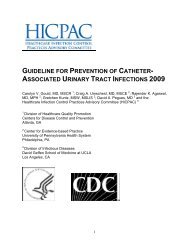SECT2.05 - Recommended Practices for Electrosurgery - Medline
SECT2.05 - Recommended Practices for Electrosurgery - Medline
SECT2.05 - Recommended Practices for Electrosurgery - Medline
- No tags were found...
You also want an ePaper? Increase the reach of your titles
YUMPU automatically turns print PDFs into web optimized ePapers that Google loves.
RP: <strong>Electrosurgery</strong>environment may enhance ignition andcombustion. 28VI.b. Conductive trocar systems should be used. 7,8,11,82Conductive trocar cannulas provide ameans <strong>for</strong> the electrosurgical current to flowsafely between the cannula and the abdominalwall. This reduces high density current concentrationand heating of non-target tissue. 7,8,11,82VI.b.1.Hybrid trocar (ie, combination plasticand metal) systems should not beused. 8,82,83Each trocar and cannula can act asan electrical conductor inducing anelectrical current from one to the otherpotentially causing a capacitive couplinginjury.VI.c. Minimally invasive surgery electrodesshould be examined <strong>for</strong> impaired insulationbe<strong>for</strong>e use. 11,83-85Insulation failure of electrodes caused bydamage during use or reprocessing providesan alternate pathway <strong>for</strong> the electrical currentto leave the active electrode. Someinsulation failures are not visible. This hasresulted in serious patient injuries. 4,7,8,11-13,85VI.c.1.VI.c.2.Methods should be used to detect insulationfailure, including but not limited to• active electrode shielding andmonitoring, 11,14• the use of active electrode indicatorshafts that have two layers of insulationof different colors, 11 and• the use of active electrode insulationintegrity testers that use high DCvoltage to detect full thickness insulationbreaks. 11Active electrode shielding continuouslymonitors the endoscopic instrumentsto minimize the risks of insulationfailure or capacitive-couplinginjuries. 4,7-9,12-14,83The inner layer of the active electrodeshaft of a different color is designed toshow through the outer black layer ifthere is an insulation break. 11Testing of the electrode be<strong>for</strong>e the procedureidentifies damaged electrodes thatshould be taken out of service. Testing ofthe electrode with the sterilizable probesand cables alerts the surgeon of an insulationbreak. The surgical field can beexplored and treated if necessary. 11,85The lowest power setting that achievesthe desired result should be selected. 83Lower power settings <strong>for</strong> both cut andcoagulation reduce the likelihood ofinsulation failure and capacitive-couplinginjuries. Lower power settings also minimizedamage from direct coupling whenthe active electrode is activated while inclose proximity to another metal deviceinserted into an adjacent trocar port. 7VI.d. The active electrode should not be activateduntil it is in close proximity to the tissue. 7,8Activation only when in close proximityto the tissue minimizes the risk of currentarcing and contacting unintended tissue. 7,8Activating the electrode when it is not invery close proximity to the targeted tissueincreases the risk of capacitive coupling.Capacitance is reduced during closed-circuitactivation.VI.e. Patients should be instructed to immediatelyreport any postoperative signs or symptomsof electrosurgical injury. Patient postoperativecare instructions should include symptomsto look <strong>for</strong>, including but not limited to– fever,– inability to void,– lower gastrointestinal bleeding,– abdominal pain,– abdominal distention,– nausea,– vomiting, and– diarrhea. 8,86Symptoms of a minimally invasive electrosurgicalinjury can occur days after dischargefrom the perioperative setting andmay include infection from an injured intestinaltract. Prompt reporting of electrosurgicalinjury symptoms ensures timely treatmentand minimizes adverse outcomes. 8,84Recommendation VIIBipolar active electrodes, including vessel occludingdevices, should be used in a manner that minimizesthe potential <strong>for</strong> injuries.Unlike the monopolar ESU, bipolar technologyincorporates an active electrode and a return electrode108Equipment and Product Safety2012 Perioperative Standards and <strong>Recommended</strong> <strong>Practices</strong>
















